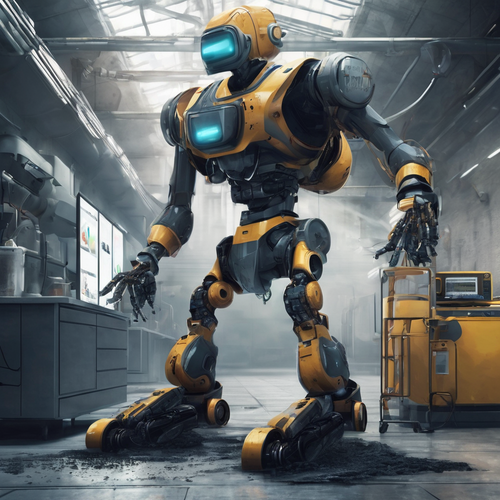Cleaning the Future: The Role of Artificial Intelligence in Industrial Cleaning Operations
In a world where every minute counts, the ancient and often mundane task of cleaning is undergoing a renaissance—one powered by artificial intelligence. Imagine a factory floor gliding into a new era, where robotic cleaners buzz around like bees, tirelessly working while humans oversee, occasionally sipping coffee while contemplating the existential dread of office life. Is it too much to dream that in this fusion of technology and cleaning, efficiency becomes as paramount as a well-timed punchline? 🤖
A New Dawn for Industrial Cleaning
Gone are the days when cleaning was relegated to scouring dirt and grime with little thought to the underlying processes. Today, the industrial cleaning landscape is transforming with the integration of cutting-edge AI technologies. From predictive maintenance to advanced robotics, the industry is embracing a strategy that contrasts sharply with its outdated predecessors—efficiency vs. inefficiency, technology vs. manual labor, cleanliness vs. chaos. Like a phoenix rising from the ashes, AI is ushering in a future where the tools we use redefine the very nature of cleanliness.
Robo-Cleaners: The Unsung Heroes
Imagine a world where cleaning crews no longer have to squint in the corners of warehouses, trying to decipher what ’mystery substance’ has decided to cling to the floor. Enter the unassuming yet industrious robotic cleaners, which float through factories like ghosts, leaving behind spotless surfaces as if by magic. These machines employ AI algorithms that enable them to learn and adapt, navigating complex environments with impressive dexterity. 🧼
But here’s the twist: while these robots excel in repetitive tasks, their capabilities extend beyond the mundane. They can analyze their surroundings, identify hotspots that require extra attention, and even calibrate cleaning methods based on the surface texture—an elegance akin to that of an artist adjusting their brush strokes. However, does this not make us ponder the irony of our reliance on technology? In a race towards efficiency, it seems we’re quite literally cleaning up our act at the expense of human employment. Can we embrace innovation without leaving our fellow workers behind?
The Predictive Cleaning Revolution
Adopting AI in industrial cleaning means moving toward a proactive rather than reactive approach. With predictive maintenance, systems analyze data from various sensors that monitor cleaning performance. It’s somewhat like having a crystal ball, foreseeing when tasks need to be performed before the mess even accumulates. Facilities can now plan cleaning schedules with precision, allocating resources efficiently—like a well-oiled machine in perfect sync. 🔧
But herein lies the paradox: while AI brings about order, it also demands a level of trust in the technology that’s akin to putting faith in an untested recipe. Will the algorithm correctly anticipate cleaning needs, or will we find ourselves knee-deep in a torrent of dirt? This delicate balance of reliance reflects the striking antithesis between our need for efficiency and our fear of over-dependence on machines—both indispensable and perhaps too convenient for our own good.
Safety and Environmental Impact
One may think that cleanliness and safety are like old friends who only visit at parties, but the relationship between AI, cleaning, and safety is becoming increasingly intertwined. Robots equipped with sensors can alert human workers of potential hazards while cleaning, which is a game-changer considering that accidents are not only costly but dangerous. An intelligent machine can identify spills or obstructions that could lead to injuries. It’s like having a wise old sage walk alongside you, warning you of impending doom while you mop the floors.
Moreover, the environmental footprint of cleaning operations is shrinking thanks to AI insights. With precise data on when and how to clean, companies can mitigate their use of harmful chemicals and reduce water consumption—echoing the sentiments of a steadfast environmentalist. Cleaning isn’t just about sparkle; it’s about sustainability, echoing the need for conscious practices in an increasingly fragile world.
A Human Touch in a World of Machines
Despite the advantages of integrating AI into cleaning operations, the human element remains fundamental. What is a cleaning protocol without the hearts and minds behind it? It’s essential to strike a harmonious balance between human insights and machine efficiency; after all, algorithms can’t make ethical decisions or adjust to unforeseen complexities that arise in dynamic environments. This highlights the poignant irony that as we move toward an automated future, the human touch might become more vital than ever.
“In the quest for efficiency, we risk losing sight of the values that define our work. Technology is a tool; it should enhance human capabilities, not replace them,” reflects industry expert Maria Santos during a recent roundtable discussion. This can serve as a guiding principle as organizations navigate this new landscape.
Embracing the Change
As we continue to embrace this brave new world of industrial cleaning, the challenge remains: how do we evolve while ensuring that technology serves humanity rather than the other way around? Here’s the million-dollar question: can we harness AI’s potential without succumbing to its pitfalls? The path forward is multifaceted, filled with opportunity and challenges. In the end, it’s about striking that elusive balance—one that Matisse would say is akin to finding harmony in a chaotic masterpiece. 🎨
So, as we sweep away the dust of the past and step confidently into a future teeming with innovation, let’s not forget the lessons learned in the proverbial trenches. Perhaps it’s time to clean up not only our spaces but our intentions, as we shape a future intertwined with technology and authenticity.
